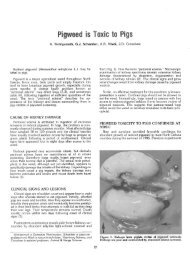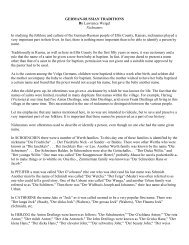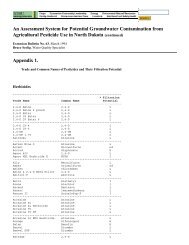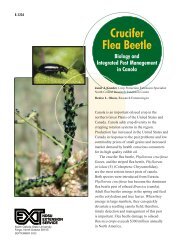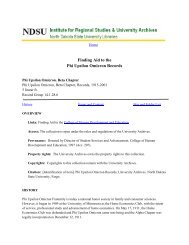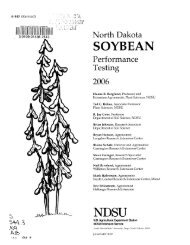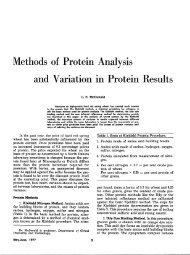germans from russia in fort collins, 1900-2000 - Libraries
germans from russia in fort collins, 1900-2000 - Libraries
germans from russia in fort collins, 1900-2000 - Libraries
Create successful ePaper yourself
Turn your PDF publications into a flip-book with our unique Google optimized e-Paper software.
WORK RENDERS LIFE SWEET: GERMANS FROM RUSSIA IN FORT COLLINS<br />
successful preservation of their Germanic<br />
heritage. But the sugar beet <strong>in</strong>dustry provided<br />
work as well as seclusion to protect German-<br />
Russian culture. Families either isolated on<br />
the edges of fields on <strong>in</strong> their own neighborhoods.<br />
In Fort Coll<strong>in</strong>s, the <strong>in</strong>timate connection<br />
between the Volga Germans and the<br />
sugar beet <strong>in</strong>dustry manifested itself physically<br />
<strong>in</strong> the geography of the Buck<strong>in</strong>gham<br />
and Andersonville neighborhoods; both<br />
developed <strong>in</strong> the shadows of the gigantic<br />
sugar factory. 25<br />
The sugar beet <strong>in</strong>dustry was itself the<br />
result of many developments. After the turn<br />
of the twentieth century, three <strong>in</strong>terrelated<br />
events led to a dramatic <strong>in</strong>crease <strong>in</strong> sugar beet<br />
production: the <strong>in</strong>crease <strong>in</strong> irrigated land, the<br />
improvement of beet varieties as well as cultivation<br />
techniques, and the construction of<br />
sugar beet process<strong>in</strong>g factories. An unnamed<br />
writer for the Work Progress Adm<strong>in</strong>istration’s<br />
Writer’s Program (a New-Deal-era makework<br />
project) called the sugar beet <strong>in</strong>dustry<br />
“the s<strong>in</strong>gle largest enterprise based upon irrigation.”<br />
26 Historian LeRoy R. Hafen, however,<br />
suggests the growth of the sugar beet<br />
<strong>in</strong>dustry promoted the development of<br />
advanced irrigation eng<strong>in</strong>eer<strong>in</strong>g projects <strong>in</strong><br />
Colorado. Sugar beets required irrigation <strong>in</strong><br />
late summer when the state’s rivers run at a<br />
trickle. In response, irrigation companies<br />
built reservoirs to store the high water of<br />
early spr<strong>in</strong>g and released it when farmers<br />
needed it for their beets.<br />
Yet, even with the best irrigation methods<br />
and soils, traditional varieties of beets<br />
produced very little sugar. A new, national<br />
<strong>in</strong>terest <strong>in</strong> the science and technology of agriculture<br />
soon changed that. Along with the<br />
Homestead Act, Republicans pushed through<br />
Congress <strong>in</strong> 1862 the Morrill Act, which created<br />
the land-grant college system. Under the<br />
act, the federal government offered states<br />
generous subsidies to establish colleges offer<strong>in</strong>g<br />
<strong>in</strong>struction <strong>in</strong> agriculture, eng<strong>in</strong>eer<strong>in</strong>g,<br />
and military science. Under this plan,<br />
Colorado established its State Agricultural<br />
College <strong>in</strong> Fort Coll<strong>in</strong>s. To accommodate its<br />
burgeon<strong>in</strong>g research work, the <strong>in</strong>stitution<br />
established the Colorado Agriculture<br />
Experiment Station <strong>in</strong> 1888, which concentrated<br />
much of its early work on improv<strong>in</strong>g<br />
the purity and percentage of usable sugar <strong>in</strong><br />
beets. By 1892, the United States Department<br />
of Agriculture rated the beets grown <strong>in</strong><br />
Larimer County as the best <strong>in</strong> world. 27<br />
But even the best beets were practically<br />
worthless without a plant nearby to process<br />
them <strong>in</strong>to granulated sugar. While farmers<br />
clamored for process<strong>in</strong>g plants, town leaders<br />
realized the potential economic boon of the<br />
<strong>in</strong>dustry. In November 1901, the Great<br />
Western Sugar Company completed <strong>in</strong><br />
Loveland the first sugar factory <strong>in</strong> northern<br />
Colorado. Fort Coll<strong>in</strong>s ga<strong>in</strong>ed its own factory<br />
<strong>in</strong> 1903. It first processed sugar a year later.<br />
As more and more factories opened <strong>in</strong><br />
towns across northern Colorado and farmers<br />
planted more and more acres of beets, the<br />
sugar <strong>in</strong>dustry boomed. But the sugar companies<br />
realized early that resident Colorado<br />
farmers were often unwill<strong>in</strong>g to endure the<br />
gruel<strong>in</strong>g labor necessary to produce a healthy<br />
and profitable crop of sugar beets. Company<br />
executives found that much of the stoop<br />
labor, especially th<strong>in</strong>n<strong>in</strong>g beets, was better<br />
suited for shorter legs and smaller hands –<br />
children. After experiment<strong>in</strong>g with labor <strong>from</strong><br />
the resident population of teenagers, the companies<br />
decided to import labor, particularly<br />
entire families. After exhaust<strong>in</strong>g the supply of<br />
landless Volga German families <strong>in</strong> Kansas<br />
and Nebraska, the sugar companies began<br />
import<strong>in</strong>g German families directly <strong>from</strong><br />
Russia. In time, Great Western transplanted<br />
entire villages to Northern Colorado. Often it<br />
SWCA Environmental Consultants Page 6



